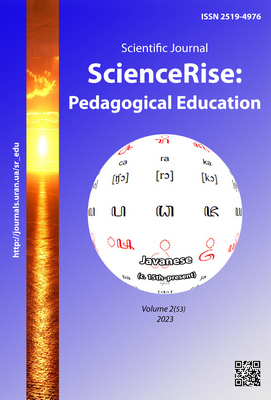The use of communicative activities for developing speaking skills of students at english lessons
DOI:
https://doi.org/10.15587/2519-4984.2023.279581Keywords:
reproductive activities, responsive activities, debatable activities, conditionally communicative exercises, communicative activities, method of visualizationAbstract
This article is devoted to the issue of the use of communicative activities for the development of speaking skills of students in the university. It was established, that the intensification of the educational process requires the search and use of new forms, methods and technologies of teaching and learning, means of supporting students' interest in the material and activation of their cognitive activity. Thus, one of the urgent problems of modern methods of teaching foreign languages is the organization of the teaching process for students of different age groups with the help of a communicative approach. The article mentions various types and subtypes of conditionally communicative and fully communicative activities, which are most commonly used to teach students speaking foreign language. The article also defines the features and the means of using certain types of speech activities, in particular, reproductive exercises, which include: 1) retelling, 2) abbreviated and selective retelling, 3) retelling-translation, 4) dramatization, 5) creative retelling. As for responsive activities, they include: 1) question-and-answer exercises, 2) replica exercises, 3) free conversation. Among the productive activities, we highlight the following: situational activities that combine 1) solving problem situations, 2) imaginary situations, 3) role-playing. Descriptive activities include various types of descriptions. The article also talks about the advantages of discussion activities, mainly 1) educational discussion, 2) commenting, 3) situational discussions, as well as compositional activities and press conferences. The article states that during the performance of communicative activities, the work should be aimed at involving students into communicatively oriented activities regarding the observation of the phenomena being studied, at revealing the connections and relationships between the means of expressing information, at finding language units for expressing one's own opinion, etc. It was established, that it is also necessary to develop communicative exercises and activities based on real-life material or a model text, which are relevant for students of a certain age, which are interesting, close and understandable for students, which have educational and socio-cultural potential
References
- Skliarenko, N. K. (2009). Typolohiia vprav v intensyvnomu navchanni inozemnykh mov. Humanistychni aspekty linhvistychnykh doslidzhen i metodyky vykladannia inozemnykh mov. Kyiv, 9–14.
- Azimov, E. G., Shchukin, A. N. (2009). Novyi slovar metodicheskikh terminov i poniatii (teoriia i praktika obucheniia iazykam). Moscow: IKAR, 448.
- Buta, O. (2015). Komunikatyvni ihry na urokakh anhliiskoi movy. Available at: https://olgabuta.wordpress.com/2015/11/24
- Mamchur, L. I. (2016). Komunikatyvni vpravy ‒ stryzhen movnoho navchannia u zahalnoosvitnii shkoli. Aktualni problemy prykladnoi linhvistyky, 7 (1), 48–51.
- Ridge, E. (2014). Communicative language teaching: Time for review? Stellenbosch Papers in Linguistics Plus, 21, 95–105. doi: https://doi.org/10.5842/21-0-533
- Sott, A. (2018). Teaching communication skills. Edutopia. Available at: https://www.edutopia.org/article/teaching-communication-skills
- Pasichnyk, O. S. (2007). Do problemy stvorennia vitchyznianykh pidruchnykiv z inozemnykh mov dlia zahalnoosvitnikh navchalnykh zakladiv. Anotovani rezultaty NDR Instytutu pedahohiky za 2006 r. Kyiv: Pedahohichna dumka, 245.
- Pentyliuk, M. (2012). Aktualni problemy suchasnoi linhvodydaktyky. Kyiv: Lenvit, 256.
- Stanfield J. (2017). 8 tips to teach effective communication skills. James Stanfield. Availanle at: https://stanfield.com/8-tips-teach-effective-communication-skills/
- Penny, U. (2009). Coursebook for language teaching. Cambridge University Press, 388.
Downloads
Published
How to Cite
Issue
Section
License
Copyright (c) 2023 Natalia Shevelova-Harkusha

This work is licensed under a Creative Commons Attribution 4.0 International License.
Our journal abides by the Creative Commons CC BY copyright rights and permissions for open access journals.
Authors, who are published in this journal, agree to the following conditions:
1. The authors reserve the right to authorship of the work and pass the first publication right of this work to the journal under the terms of a Creative Commons CC BY, which allows others to freely distribute the published research with the obligatory reference to the authors of the original work and the first publication of the work in this journal.
2. The authors have the right to conclude separate supplement agreements that relate to non-exclusive work distribution in the form in which it has been published by the journal (for example, to upload the work to the online storage of the journal or publish it as part of a monograph), provided that the reference to the first publication of the work in this journal is included.








